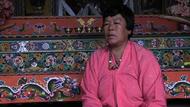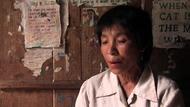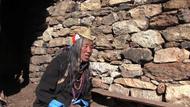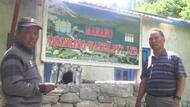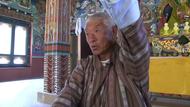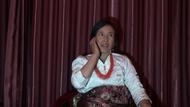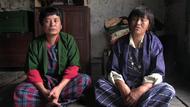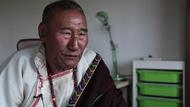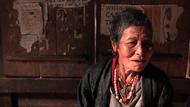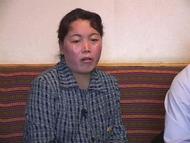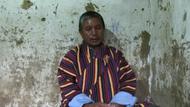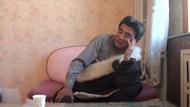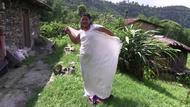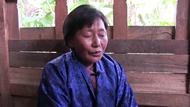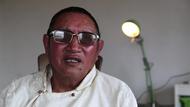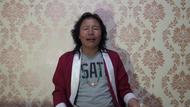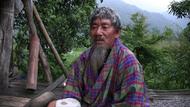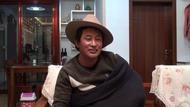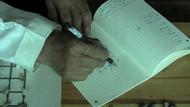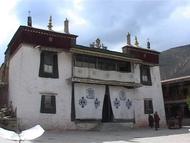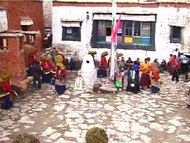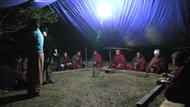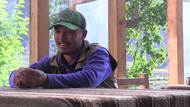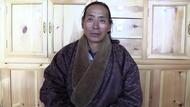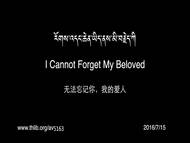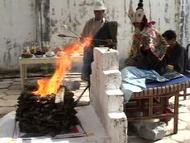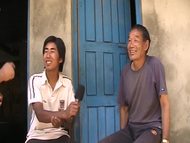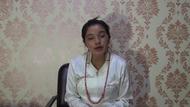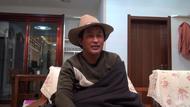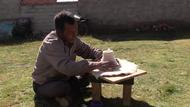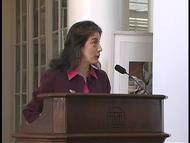Video Overview
A monk presents a brief history of Samyé Monastery.
- Ü
- Samyé Gön
- བློ་བཟང་མཁས་རབད་ལྟ་འདིར་བསམ་ཡས་གཙུག་ལག་ཁང་ཞེས་པ་འདི་ནི་བཞེངས་ནས་ད་བར་ལོ་རྒྱུས་་་་ལོ་ཆིག་སྟོང་ཉིས་བརྒྱ་བཞི་བཅུ་ཞེ་ལྔ་ཙམ་ཅིག་ལྡན་པའི་ལོ་རྒྱུས་དེ་འདྲས། བོད་ཀྱི་བསམ་ཡས་གཙུག་ལག་ཁང་ཟེར་དཱ་དགོན་སྡེ་ཆེ་བའི་གྲས་ཤིག་ཡིན་པ།It has been 1245 years since Samye Temple was built. It has a long history. It is one of the biggest temples in Tibet.
- བློ་བཟང་མཁས་རབདེ་ཡང་ད་ཐོག་མར་བོད་ཀྱི་རྒྱལ་པོ་སྲོང་བཙན་སྒམ་པོའི་དུས་ལ། ལྷ་ས་གཙུག་ལག་ཁང་ལ་སོགས་པ་དེ་འདྲས་བཞེངས་ནས། བོད་ཀྱི་ཡི་གེ་ལ་སོགས་པ་དེ་འདྲས་སྲོལ་བཏོད་ནས་སངས་རྒྱས་བསྟན་པ་དབུ་བརྙེས་པ།And, the Jokhang temple was built during the time of king Songtsen Gampo, and he introduced the Tibetan letters and Buddhism for the first time.
- བློ་བཟང་མཁས་རབདེའི་རྗེས་ལ་རྒྱལ་རབས་ལྔ་སོང་བ་ན། རྗེ་བཙུན་འཇམ་དཔལ་དབྱངས་ཀྱི་རྣམ་སྤྲུལ། རྒྱལ་པོ་ཁྲི་སྲོང་ལྡེ་བཙན་གང་ཡིན་པ་དེ་ཉིད། བསམ་ཡས་ཡུལ་འདིར་འཁྲུངས་ནས། ཁོང་གིས་ཀྱང་སྔོན་གྱི་དཱ་ཡབ་གོང་མ་རྣམས་ཀྱི་བཀའ་དྲིན་གསོ་བའི་ཆེད་དུ།And after five royal kings, king Trison Detsen, an emanation of Manjushri was born here in the region of Samye. In order to repay the kindness of his ancestors
- བློ་བཟང་མཁས་རབདེ་ནི་གཙུག་ལག་ཁང་ཡབ་གོང་མ་རྣམས་ཀྱིས་གཙུག་ལག་ཁང་གཞན་དག་ཁ་ཐོར་བཞེངས་བཞག་འདུག། འོན་ཀྱང་གུས་པ་ནི་གཙུག་ལག་ཁང་རྦད་དེ་གླིང་གཅིག་གི་ནང་དུ་གཙུག་ལག་ཁང་ཡོངས་སུ་རྫོགས་པ་ཆ་ཚང་གཅིག་བཞེངས་་་བཞེངས་ཀྱི་ཡིན་ཟེར་བྱས་ནས།he promised that he would build a temple in its complete form in one single location [unlike] the temples that were built in scattered locations by his ancestors.
- བློ་བཟང་མཁས་རབཁོང་གིས་དམ་བཅའ་དེ་འདྲས་གསུངས་ནས། དེ་ནི་བློན་འབངས་རྣམས་ལ་བཀའ་གྲོས་མཛད་ནས། བསམ་ཡས་གཙུག་ལག་ཁང་འདི་ཉིད་འདིར་བཞེངས་ཡས་ཀྱི་བཀའ་གྲོས་མཛད།He discussed his plan of building Samye Temple with his ministers.
- བློ་བཟང་མཁས་རབདེ་ཉིད་བཞེངས་པར་བྱེད་པ་ལ་ཡང་ལྷ་སྲིན་སྡེ་བརྒྱད་ལ་སོགས་པ་དེ་དག་ཐམས་ཅད་ཀྱིས་བར་དུ་གཅོད་པའི་གེགས་ལ་སོགས་པ་དེ་འདྲ་མང་པོ་བྱས་ནས། ཐོག་མར་ཁོང་རྣམས་པ་གསུམ་དཱ་སྔོན་བལ་ཡུལ་མཆོད་རྟེན་བྱ་རུང་ཁ་ཤོར་བཞེངས་པ་དེ་ཉིད་དུས་ལ།The eight groups of worldly gods and demons interfered greatly with the construction of the temple. Due to the prayer that these three figures made while building the Baudanath temple in Nepal,
- བློ་བཟང་མཁས་རབསྨོན་ལམ་བཏབ་པ་ལ་བརྟེན་ནས་རྒྱ་གར་ནས་མཁན་ཆེན་བོ་དྷི་ས་ཏྭ་ཚུར་གདན་དྲངས། མཁན་ཆེན་བོ་དྷི་ས་ཏྭ་ཁོ་རང་བྱང་ཆུབ་མཆོག་ཏུ་ཐུགས་བསྐྱེད་པ་ཡིན་ཙང་། འདི་དག་ལྷ་སྲིན་གདུག་པ་ཅན་འདི་དག་འདུལ་བ་ཤིན་ཏུ་ནས་དཀའ་བ་ཡིན་ཀྱང་། འོན་ཀྱང་མཁན་ཆེན་ཞི་བ་འཚོ་ཡིས་ལུང་བསྟན་ནས།Santaraksita was invited from India. Since Santaraksita was a bodhisattva, it would be difficult for him to control these evil wordly gods and demons. Nonetheless, he prophesized that
- བློ་བཟང་མཁས་རབརྒྱ་གར་ནས་སློབ་དཔོན་པད་མ་འབྱུང་གནས་གདན་དྲངས་དགོས་ཟེར། དེ་འདྲེན་པ་ཡིན་ན་བསམ་ཡས་གཙུག་ལག་ཁང་དེ་ལེགས་པར་བཞེངས་ཐུབ་ཀྱི་ཡོད། དེ་གདན་འདྲེན་མི་ཐུབ་ན་བསམ་ཡས་གཙུག་ལག་ཁང་དེ་ཡང་ཤིན་ཏུ་ནས་ཀྱང་བཞེངས་དཀའ་བ་ཡིན།Padmasambava be invited to Tibet from India. If they invited him the Samye Temple could be built successfully. If they could not invite him it would be extremely difficult to build the temple.
- བློ་བཟང་མཁས་རབགང་ཡིན་ཟེར་ན། བོད་ལ་ལྷ་སྲིན་གདུག་པ་ཅན་དེ་འདྲས་མང་པོ་ཡོའོ་༿ཡོད་༾རེད། འོན་ཀྱང་སངས་རྒྱས་བསྟན་པ་དེ་ཉིད་ཡར་སླར་གསོ་བྱེད་ཡས་ལ་ཤིན་ཏུ་ནས། ཁོང་ཚོས་འཚེ་བ་བྱས་བྱས་གནོད་པ་མང་པོ་བསྐྱལ་ཀྱི་རེད་ཟེར།Because, [he said] there were many evil worldly gods and demons in Tibet. They would always obstruct the revival of the Buddha dharma.
- བློ་བཟང་མཁས་རབཨ་ནི་་་་ཡིན་ནའི་ལའི་རྒྱལ་པོ་དེ་གས་༿ཡིས་༾མཁན་ཆེན་བོ་དྷི་ས་ཏྭ་རྒྱལ་པོ་ཁྲི་སྲོང་ལྡེ་བཙན་ལ་སློབ་དཔོན་རིན་པོ་ཆེ་པད་མ་འབྱུང་གནས་ཚུར་གདན་དྲངས་ན་ཁྱེད་ཀྱི་གཙུག་ལག་ཁང་དེ་ལེགས་པར་གྲུབ་ཀྱི་ཡིན་ཟེར་བྱས་བྱས་དེ་འདྲས་གསུངས་བྱས།Nonetheless, said Santaraksita to the king Trisong Detsen, if you invited Padmasambhava here your temple would be built successfully.
- བློ་བཟང་མཁས་རབདེ་ནི་རྒྱལ་པོ་ཁྲི་སྲོང་ལྡེ་བཙན་གྱིས་ཁོང་གི་བློན་པོ་སྦ་གསལ་སྣང་ལ་སོགས་པ་དེ་འདྲས་རྒྱ་གར་ལ་བརྫངས་ནས་སློབ་དཔོན་པད་མ་འབྱུང་གནས་རྒྱ་གར་ནས་ཚུར་གདན་དྲངས། རྒྱ་གར་ནས་ཚུར་གདན་དྲངས་བ་ལ་བརྟེན་ནས།The king Trisong Detsen dispatched his ministers such as Ba Selnang, etc. to India and invited Padmasambhava from India. After having invited from India,
- བློ་བཟང་མཁས་རབསློབ་དཔོན་དང་ཆོས་རྒྱལ་དང་མཁན་ཆེན་དང་ཁོང་རྣམ་པ་གསུམ་དཱ་མཁན་སློབ་ཆོས་གསུམ་ཟེར་ཡས་དེ་ཉིད་འཛོམས་ནས། ཆོས་རྒྱལ་གྱིས་གཙུག་ལག་ཁང་དེ་ཉིད་བཞེངས་བར་བྱེད་པ་ལ་ཡོན་སྦྱར། སྦྱར་བ་ལ་བརྟེན་ནས་རྒྱ་གར་ནས་མཁན་ཆེན་བོ་དྷི་ས་ཏྭ་དང་སློབ་དཔོན་པད་མ་འབྱུང་གནས་གཉིས་གདན་དྲངས་ནས། དེ་ནི་ཁོ་རྣམ་ཚོ་གསུམ་ཞལ་འཛོམས་ནས་ས་གཞི་བྱིན་གྱིས་བརླབས་མཁན་ཆེན་གྱིས།the so-called trio of scholars, acarya, and the dharma king met. The dharma king provided material support to build the temple. Due to the king's material support, Santaraksita and Padmasambhava were invited. And the three of them met. The Great Scholar [Santaraksita] blessed the place.
- བློ་བཟང་མཁས་རབདེ་ནི་ད་ག་ནང་བཞིན་སློབ་དཔོན་རིན་པོ་ཆེ་པད་མ་འབྱུང་གནས་ཀྱིས། ལྷ་སྲིང་གདུག་པ་ཅན་དེ་དག་ཐམས་ཅད་དམ་ལ་བཏགས་ནས། རྒྱ་གར་ཨོ་ཏནྟ་པ་རིའི་གཙུག་ལག་ཁང་གི་དཔེ་བླངས་ནས།And, Padmasambhava, the Precious Acarya, put the evil wordly gods and demons under his control. And based on the architecture of Odantapuri Temple
- བློ་བཟང་མཁས་རབདེ་ནི་བསམ་ཡས་མི་འགྱུར་ལྷུན་གྱིས་གྲུབ་པའི་གཙུག་ལག་ཁང་འདི་ཉིད་བཞེངས་པར་མཛད་པ་ཡིན་ཟེར། དེ་བཞེངས་པར་མཛད་པའི་རྒྱུ་མཚན་གང་ཡིན་ཟེར་ན།the Samye Migyur Lhungyi Dubpai Temple was built. The reason why he built this temple is because
- བློ་བཟང་མཁས་རབསྔོན་དཱ་སྲོང་བཙན་སྒམ་པོས་སངས་རྒྱས་བསྟན་པ་སྲོལ་བཏོད་པ་དང་། དེ་ནི་ངས་ཀྱང་སངས་རྒྱས་བསྟན་པ་ལ་བྱ་བ་རླབས་པོ་ཆེ་གཅིག་བྱེད་དགོས་ཀྱི་འདུག་ཟེར། འདིའི་ནང་ལ་བོད་ལ་རབ་བྱུང་ཞེས་པ་འདི་ཐོག་མར་སྒྲ་ཙམ་ཡའི་༿ཡང་༾མེད་པ་ལ་བརྟེན་ནས།it occured to him that Songtsen Gampo started Buddhism in Tibet in the past and he had to something extraordinary for Buddhism. Since the word 'monk' was unheard of in Tibet during that period...
- བློ་བཟང་མཁས་རབརྒྱལ་པོ་དེའི་དུས་ལ་དཱ་ཁྲི་སྲོང་ལྡེ་བཙན་གྱི་དུས་ལ། དེ་ནི་བསམ་ཡས་སྲས་མི་བདུན་དེ་གྱད་ཐོག་མར་རབ་ཏུ་བྱུང་ནས་དེ་ནི་བོད་ལ་དགོན་སྡེ་དང་པོ་ཟེར་ནའི་འདྲ་ལ། གྲྭ་པ་ཐོག་མར་ཟེར་ནའི་འདྲ། དཔལ་ལྡན་རབ་བྱུང་ཐོག་མའི་གྲྭ་ཚང་ཟེར་ན་གང་བྱས་རྒྱུ་མཚན་དེ་ནས་བྱུང་པ་རེད་ཟེར།it was during the time of this king, Trisong Detsen, that the first group of seven monks were ordained. Due to this, whether you want to call it the first monastery in Tibet, or the first group of monks, or a monastery for the first glorious group of monks, it all began here.
- བློ་བཟང་མཁས་རབདཱ་རྒྱ་གར་གཙོ་བོ་ཉན་ཐོས་ཡོད་པར་སྨྲ་བའི་ལུགས་སུ་བྱས་ནས། མཁན་ཆེན་བོདྷི་ས་ཏྭས་གནམ་བདག་ཁྲིམས་ཁང་ནང་ལ་སྲས་མི་བདུན་རབ་དུ་བྱུང་ནས། དེ་ནི་བོད་ལ་ཐོག་མར་དཱ་གྲྭ་པ་ཞེས་དང་།Santaraksita ordained the group of seven monks at Namdak Drikhang based on the Sarvastivada tradition of Sravaka Vehicle.
- བློ་བཟང་མཁས་རབ་
- བློ་བཟང་མཁས་རབད་ག་ནང་བཞིན་དགོན་སྡེ་ཞེས་པའི་སྒྲ་དེ་ཐོག་མར་བྱུང་ཡོའོ་༿ཡོད་༾རེད་ཟེར། དེ་བསམ་ཡས་ནས་བྱས་དར་ནས། དེ་ནི་དེའི་རྗེས་ལ་དཱ་བསམ་ཡས་གཙུག་ལག་ཁང་དེ་ལེགས་པར་གྲུབ་ནས། ཁོང་རྣམ་པ་ད་མཁན་ཆེན་བོ་དྷི་ས་ཏྭ་ཀྱང་༿ཡང་༾སྐུ་མྱ་ངན་དགོངས་པ་མྱ་ངན་ལས་འདས། དེ་དང་ཕྱོགས་མཚུངས་པའི་སློབ་དཔོན་པད་མ་འབྱུང་གནས་ཀྱང་། ལྷོ་ནུབ་སྲིན་པོའི་ཡུལ་ལ་སེམས་ཅན་ཀྱི་དོན་དུ་ལྷོ་ནུབ་སྲིན་པོའི་ཡུལ་ལ་བསྡད།And the terms 'monk' and 'monastery' were also coined for the first time in Tibet. They spread from the Samye temple. After the successful completion of Samye temple, the scholar Santaraksita passed away. Padmasambhava, on the other hand, resided in the Demon Land in the Southwest for the well being of sentient beings.
- བློ་བཟང་མཁས་རབརྒྱལ་པོ་ཁྲི་སྲོང་ལྡེ་བཙན་ཡང་སོ་སོའི་གདུལ་བྱ་རྫོགས་པ་ལ་བརྟེན་ནས་དགོངས་པ་ཆོས་དབྱིངས་སུ་ཕེབས། དེ་དེའི་རྗེས་སུ་འདི་ལ་བསམ་ཡས་འདི་ལ་ད་བོད་གངས་ཅན་ལྗོངས་ནང་ལ་སྐད་གྲགས་ཆེ་བའི་བླ་མ་སྐྱེས་ཆེན་དམ་པ་ཡིན་ནའི་འདྲ་ལ། ཆོས་ལུགས་གྲུབ་མཐའ་རིས་སུ་མ་མཆིས་པ། ཕྱོགས་སུ་མ་ལྷུངས་པའི་སྐྱེས་བུ་དམ་པ་རྣམས་ཀྱི་མཛད་རྗེས་བསམ་གྱིས་མི་ཁྱབ་པ་བརྟེན་ནས།The king Trisong Detsen passed away because he longer had any more disciples. Later many great famous lamas belonging to all different religious sects, who are not biased to any tradition, in Tibet have
- བློ་བཟང་མཁས་རབཉམ་གསོ་ལ་སོགས་པ་རིམ་པ་ལྔ་ཙམ་མཛད། འདི་ལ་ཉམས་གསོ། ཁོ་ར་འཕེལ་གྲིབ་བྱུང་བ་ལ་བརྟེན་ནས་ཉམས་གསོ་ཀྱང་བྱས། དེས་ཀྱང་འདི་ལ་དཱ་བོད་ཀྱི་ཆོས་འཁོར་རྣམ་པ་གསུམ་གྱི་་ཐོག་ནས་བཤད་པ་ཡིན་ན།renovated it five times. They renovated it because of the damage it suffered. And if we speak from the perspective of the three sets of offerings in Tibet
- བློ་བཟང་མཁས་རབལྷ་ས་སྨོན་ལམ་གྱི་མཆོད་པ་དང་། བསམ་ཡས་མདོ་སྡེའི་མཆོད་པ། ཁྲ་འབྲུག་མེ་ཏོག་མཆོད་པ་བྱས་ནས་མདོར་བསྡུས་ནས་བཤད་ན། སྡེ་སྣོད་གསུམ་གྱི་མཆོད་པ་ཡིན་པ་དང་། སྡེ་སྣོད་གསུམ་གྱི་མཆོད་པ་དེ་ཡིན་ན།Lhasa is the prayer offering, Samye is the Sutra offering, and Tradruk is the flower offering. In brief, these are the offerings of the three sets of dharma teachings.
- བློ་བཟང་མཁས་རབལྷ་ས་གཙོ་བོ་འདུལ་བའི་མཆོད་པ་ཡིན་པ་དང་། དེ་ནི་འདུལ་བའི་དེ་ལ་སྨོན་ལམ་མཆོད་པ་ཟེར་བྱས་ཕར་སྒྲ་དེ་བསྒྱུར་བྱས་དེ་ནི་དེ་འདྲས་བཤད་བྱས། དཱ་བསམ་ཡས་ཡིན་ཡས་བྱས་ན་མདོ་སྡེའི་མཆོད་པ་དེ་ལ་མདོ་སྡེའི་མཆོད་པ་ཟེར་བྱས་ནས། དམིགས་བསལ་གྱི་དཱ་མདོ་སྡེའི་གནས་སྐབས་སུ་གཙོ་བོ་བྱས་ན་སངས་རྒྱས་དང་བྱང་ཆུབ་སེམས་དཔའི་དྲི་བ་དྲི་ལན་གྱི་ཚུལ་དུ་ཡིན་པ་རེད་དའི།Generally speaking, Lhasa is the Vinaya offering. But, the term 'dul ba'i mchod pa' was changed into 'smon lam mchod pa.' As for Samye, even though it is considered as the Sutra offering, [it is not as same as the traditional Sutra set] wherein conversations between the Buddha and bodhisattvas take place.
- བློ་བཟང་མཁས་རབཡིན་ནའི་ལའི་ཁོ་མདོ་སྡེའི་མཆོད་པ་དེ་ལ་གཙོ་བོ། བསམ་ཡས་ཀྱི་གུ་རུ་རིན་པོ་ཆེ་ཡི་གང་ཟེར་དགོས་པས། ད་ཚེས་བཅུ་དང་འབྲེལ་བའི་མདོ་སྡེའི་གར་འཆམ་གྱི་འཁྲབ་མཚན་དེ་འདྲས། ཁོ་ར་ཕར་འཁྲབ་སྟོན་བྱེད་ཡས་ཀྱི་ལེ་ཚན་དེ་འདྲས་གཏིང་བྱས། དེ་བྱེད་དགོས་ཡས་ཀྱི་རྒྱུ་མཚན་གང་རེད་ཟེར་ན།In any case, the primary Sutra offering here is the Sutra ritual dance of Guru Padmasambhava that takes place on the 10th of the Tibetan lunar calendar. The reason for doing such ritual dance is that...
- བློ་བཟང་མཁས་རབསློབ་དཔོན་རིན་པོ་ཆེ་ཁོ་རང་ལྷོ་ནུབ་སྲིན་པོའི་ཡུལ་ལ་བཞུགས་བ་དང་། ད་ག་ནང་བཞིན་ཟངས་མདོག་དཔལ་རི་ལ་བཞུགས་པའི་གནས་སྐབས་སུ་མཛད་རྣམ་གང་འདྲས་ཅིག་ཡོད་མེད་དེའི་ཁོ་ར་བཀོད་པ་དེ་འཇིག་རྟེན་ཁམས་འདི་ལ་སྣང་བར་མཛད་ནས། དེ་ནི་གུ་རུ་ཆོས་ཀྱི་དབང་ཕྱུག་ཀྱིས་གཏེར་ཆོས་དཱ་གཅིག་ནང་པའི་སངས་རྒྱས་པའི་ཆོས་ཁོ་ར་ཁོ་ར་དཀྱིལ་འཁོར་ཞལ་མཇལ་ཡས་ཆ་ཚང་ཅིག་མགོ་སེམས་བསྐྱེད་ནས་མཇུག་བསྔོ་བ་བར་དུ་ཆ་ཚང་གཅིག་ཡོད་པ།it displays on this earth the life story of Padmasambhava or what Padmasambhava does while residing in the Demon Land of the Southwest and Zangdok Palri. And Guru Choeki Wangchuk had a vision of the treasure dharma consisting of Buddhist mandalas and [the paths] ranging from the generation of bodhicitta to the dedication prayer.
- བློ་བཟང་མཁས་རབདེའི་ནང་ལ་དེ་ནི་གུ་རུ་མཚན་བརྒྱད་ཀྱི་མཛད་རྣམ་དང་། ད་ག་ནང་བཞིན་ཅིག་ཐོག་མར་བསམ་ཡས་མདོ་སྡེ་ཟེར་ཡས་དེ་དཔེར་ན་ད་རིང་འདོན་ཡས་ཀྱི་འཆམ་དེ་ལ་མཚོན་པར་བྱས་ན།Also included in it are the life stories of the 8 forms of Guru Padmasambhava. Similarly, as for the Samye Sutra offering, for instance, the ritual dance that we did today, it
- བློ་བཟང་མཁས་རབགཙོ་བོ་ཚེས་བཅུའི་འཆམ་ཡིན་པ། ཚེས་བཅུའི་འཆམ་དེ་ཉིད་ཀྱང་ཐོག་མར་ཆོ་ག་དེ་རིམ་པ་བཞིན་དུ་བྱས་ནས། ཐོག་མར་གསེར་སྐྱེམས་འདོན། གསེར་སྐྱེམས་དེ་གིས་༿ཡིས་༾ས་གཞི་བྱིན་གྱིས་བརླབས།is primarily the 10th Dance [a dance performed on the 10th day of the Tibetan lunar calendar.] The 10th Dance progresses step by step beginning with the Liquid Offering ritual (Serkyem), which blesses the area.
- བློ་བཟང་མཁས་རབས་གཞི་བྱིན་གྱིས་བརླབས་ཚར་ནས། དེའི་རྗེས་ལ་མཚམས་གཅོད་འདོན། མཚམས་གཅོད་དེ་གས་༿ཡིས་༾ས་གཞི་ཐམས་ཅད་མཚམས་བཅད་ནས། འདི་ཚུན་ཆད་དེ་རྦད་དེ་ཡེ་ཤེས་པ་བྱིན་གྱིས་བརླབས་པའི་དཱ་ཁོ་ར་དཀྱིལ་འཁོར་ཞེས་ལས་བྱ་བའི་ས་གཞི་ཡིན།After the blessing of the area, the Area-marking prayer (Tsamchod) is recited. It marks the area indicating that beyond this point is an activity area called mandala that is blessed by Wisdom-beings,
- བློ་བཟང་མཁས་རབདེ་ཕན་ཆད་དེ་གས་༿ཡིས་༾ལས་བྱེད་དུ་མི་རུང་བའི་ས་གཞི་ཡིན་ཟེར་བྱས་ནས་ཁོ་ར་མཚམས་བཅད། མཚམས་ཆད་པའི་རྗེས་སུ་དཱ་སྤྱན་འབེབས་ཟེར་ཡས་དེ་འཆམ་སྤྱན་འབེབས་ཟེར་ཡས་དེ་དང་སྤྱན་འབེབས་ཟེར་ཡས་དེ་གས་༿ཡིས་༾ཁོ་ར།and beyond that point is a non-activity area. After such Area-marking prayer, an invocation prayer, or the invocation prayer for ritual dance is recited.
- བློ་བཟང་མཁས་རབས་གཞི་འདི་བྱིན་གྱིས་བརླབས། བྱིན་གྱིས་བརླབས་ནས་ད་ས་གཞི་འདིའི་སྒང་ལ་ཡེ་ཤེས་པ་དངོས་སུ་བཏིང་། ཡེ་ཤེས་པ་དངོས་སུ་བཏིང་བ་ལ་བརྟེན་ནས། དེ་ནི་ཁོ་ར་དུར་བདག་ཟེར་བྱས་དུར་ཁྲོད་བདག་པོ་ཟེར་བྱས་དེ་གཉིས་འདོན། དུར་ཁྲོད་བདག་པོ་གཉིས་གིས་༿ཀྱིས་༾ཁོ་རའི་དཔེ་ཆ་བཞག་ན།Invocation prayer is a prayer that blesses an area. Once the blessing is done, the Wisdom beings are literally laid out on the area. Once the Wisdom-beings are literally laid out, they recite the Cremation Lord prayer twice. The two Cremation Lords...
- བློ་བཟང་མཁས་རབའཇིག་རྟེན་ཁམས་ལ་གནོད་ཅིང་འཚེ་བར་བྱེད་པའི་སངས་རྒྱས་བསྟན་པ་ལ། ལོག་པར་སྤྱོད་པའི་དཱ་གང་ཟེར་དགོས་པས། དམ་སྲི་འབྱུང་པོའི་རིགས་སུ་གྱུར་བ་དེ་དག་ཐམས་ཅད་ཀྱི་རྣམ་ཤེས་དེ་ཚུར་ལིང་དེ་ལ་ཚུར་བཏིང་། རྣམ་ཤེས་དེ་ཚུར་བཀུག རྣམ་ཤེས་དེ་ཚུར་བཀུག་པ་ལ་བརྟེན་ནས་དཱ་དེའི་རྗེས་ལ་དེ་ནི་གཏུམ་ངག་ཟེར་ཡས་ཅིག་འདོན། འཆམ།lay out the consciousnesses of those who mistreat Buddhism and those who harm the world such as Damsi (spirits who have previously broken their commitments), Jungpo (spirits associated with elements), and so forth. Once the consciousnesses have been summoned, they will do the prayer or the ritual dance called Tumngag.
- བློ་བཟང་མཁས་རབགཏུམ་ངག་ཟེར་ཡས་དེ་གིས་༿ཡིས་༾རྣམ་ཤེས་དེ་རྦད་དེ་ཡར་སྤར་ནས། དཱ་ཁོའི་དགྲ་སྤྱོད་ལོག་པར་འདྲེན་པའི་རྣམ་ཤེས་དེ་ཡིན་ཀྱང་། འོག་མིན་པད་མ་འོད་ཀྱི་ཞིང་ཁམས་ཟངས་མདོག་དཔལ་རི་ལ་ཡར་སྤེལ་ནས། དེ་ནི་ཁོ་བོའི་དཱ་ཕུང་པོ་དེ་བདུད་རྩིར་གྱུར།The Tumngag prayer transmits the consciousnesses. Even though these are the consciousnesses of those who lead people to the wrong spiritual paths, [their consciousnesses still get] transmitted to Zangdog Palri, the Land of Padma O. Their bodies turn into nectar.
- བློ་བཟང་མཁས་རབཕུང་པོ་རོ་ཏོ་དེ་བདུད་རྩིར་གྱུར་ནས། བདུད་རྩིར་གྱུར་བ་ལ་བརྟེན་ནས། དེའི་རྗེས་སུ་དེ་ནི་བདུད་རྩིའི་རོ་ཏོ་དང་ཕུང་པོ་ལྷག་མ་དེ་གཉིས་དེ་གང་གིས་བཞེས་ཡོད་ཟེར་ན། ཚོགས་ལེན་ཟེར་ཡས་ཅིག་ཁོ་ར་ཚོགས་ཀྱི་དེ་རིམ་པ་གཅིག་འདོན། འཆམ། ཨོའོ་་་་དེ་ཚོགས་ལེན་ཟེར་ཡས་དེ་གིས་༿ཡིས་༾ཁོ་རའི་ཤ་ཁྲག་གི་དཱ་བདུད་རྩིའི་འཕྲོ་དེ་གས་༿ཡིས་༾དེ་ཡོངས་སུ་རྫོགས་པ་དེ་གྱད་འགང་ག་༿ཚང་མ་༾ཁོང་ཚོས་བཞེས།The dead bodies turn into nectar. Who eats these leftover nectar and the dead bodies, after they have been turned into nectar? They do the ritual called tsoglen, another cycle of dance ritual. The tsoglen eats all the leftover nectar and the dead bodies.
- བློ་བཟང་མཁས་རབདེ་བཞེས་ཚར་བ་ལ་བརྟེན་ནས། ཐོག་མར་ཚོགས་ལེན་ཟེར་ཡས་དེ། སྲིན་པོ་ཡིན་པ། དེ་ནས་ཚོགས་ལྷག་དེ་བཟས་ཚར་ནས། དེ་ནི་བསྐོར་ར་འདུག་ཟེར་༿བཟོ་༾གཡོན་བསྐོར་རྒྱག་དགོས་ཡས་དེ། དེ་ནི་ཁོ་དངོས་སུ་དཱ་རྦད་ཏོག་ཙམ་ཁོའི་རྒྱུད་ལ་ཐུན་མོང་མ་ཡིན་པའི་ཡེ་ཤེས་དེ་འདྲས་སྐྱེས་བྱས།Initially the tsoglen was a demon. After he ate the leftover nectar, he will make a circumumbalation counter clockwise. The reason why he circumumbalates that way is because he has generated some extraordinary realizations.
- བློ་བཟང་མཁས་རབདེ་ནས་སྲིན་པོ་ནས་ཡར་ཁོ་རའི་གནས་དེ་ཡག་རུ་༿ཏུ་༾ཕྱིན་བྱས། རྦད་དེ་དེའི་བཟོ་འདྲ་གཅིག་ཆགས་པ། བྱང་སེམས་བཟོ་འདྲ་ཅིག་ཆགས་པ། དེ་ནི་དེའི་རྗེས་ལ་རྐྱེན་ཟེར་ཡས་དེ་འདོན་ནས། དཱ་རྐྱེན་ཟེར་ཡས་དེ་གཙོ་བོ་ཁོ་རའི་ཟངས་མདོག་དཔལ་རི་ཁོའི་ཉེ་འགྲམ་དུ་ཡོད་པའི་གང་ཟེར་དགོས་པ།Due to this, his status improved from being a demon to something like a bodhisattva. After that, they will recite the prayer called Kyen. Kyen lives near Zangdog Palri. {note: someone should check the name of the ritual which is transcribed here as 'rkyen'}
- བློ་བཟང་མཁས་རབདཱ་སློབ་དཔོན་རིན་པོ་ཆེ་དང་དཱ་ད་ག་ནང་བཞིན་གྱི་ཟངས་མདོག་དཔལ་རིའི་ནང་ཡོད་པའི་ཁོ་འགལ་རྐྱེན་བར་ཆད་སྲུང་མཁན་གྱི་རྐྱེན་ཡིན་ཙང་། རྐྱེན་གྱིས་ཁོ་ཚོགས་ལེན་གྱིས་ཚོགས་བཟའ་ཡས་ཀྱི་དུས་ཚོད་དེ་ཕར་དཀྲུགས་ཕྱིན་བྱས། དེ་ནི་ཁོ་ཟ་རུ་མ་བཅུག་བྱས། དཀྲོགས་པའི་བཟོ་འདྲ་གཅིག་བྱས་བྱས། ཁོ་དཀྲོགས། དེ་ནས་ཡར་མཛུལ་ནས། དེ་ནི་གཞི་ནས་རྐྱེན་གྱི་མཆོད་པ་རྐྱེན་ཁོ་རང་གི་མཆོད་པ་དེ་འདོན།Since Kyen's job is to protect Padmasambhava and Zangdok Palri from obstacles, he disturbs Tsoglen when Tsoglen is eating the tsog offering. He does not make Tsoglen finish the tsog offering. He sort of expels Tsoglen and he enters in it. Then the Kyen offering, his own offering, is done.
- བློ་བཟང་མཁས་རབདཱ་རྐྱེན་ཁོ་རང་གི་མཆོད་པ་དེ་འདོན་ཚར་པའི་རྗེས་ལ། དེ་ནི་ཁོ་བོའི་རྐྱེན་གྱི་རིམ་པ་དེ་རྫོགས་ཚར་སོང་ན། ད་ག་ནང་བཞིན་ཞེན་སྐྱོངས་ཟེར་ཡས་ཅིག་འདོན། འཆམ། ཞེན་སྐྱོངས་ཟེར་ཡས་དེ་གིས་༿ཡིས་༾གང་བྱེད་ཡས་རེད་ཟེར་ན།When the Kyen offering is completed, when the round of Kyen ritual is finished, it is followed by the round of dance called Zhinkyong. What does Zhingkyong do?
- བློ་བཟང་མཁས་རབགཙོ་བོ་དེ་ཡི་དམ་རྟ་འགྲིན་ཡིན་པ། ཡི་དམ་རྟ་འགྲིན་རྟ་པ་ཡབ་ཡུམ་དེ་གས་༿ཡིས་༾གཙོ་བོ་ཆེ་བ་དེ། དཱ་དེའི་ནང་ལ་ཅིག་ཚོགས་ལེན་དང་། ད་ག་ནང་བཞིན་གྱི་དཔལ་མགོན་མ་ཎི་དང་། ད་ག་ནང་བཞིན་གནོད་སྦྱིན་ཆེན་པོ་དང་།Here the primary deity is Hayagriva with his consort. And within it there are Tsoglen, Palgon Mani, and the Great Noejin.
- བློ་བཟང་མཁས་རབད་ག་ནང་བཞིན་ཅིག་ཁོ་རའི་ཚོགས་ལེན་ནང་ལ་ཡ། ཡང་ཁག་དྲུག་ཙམ་ཅིག་དེའི་ནང་ལ་བསྡུས་བྱས། དེ་ནི་ལྔ་པོ་དང་བཅས་པ་ཚུར། ཁོ་རའི་འཆམ་གྱི་ལེ་ཚན་དེ་མ་སོང་ན། ཁག་གཉིས་གསུམ་བཞི་ལྔ་ཁག་ལྔ་ཙམ་ཅིག་ཚུར་འཛོམས་བྱས།And there are around 6 groups that are included within Tsoglen also. All five of them, two, three, four, and five ritual pieces are gathered together.
- བློ་བཟང་མཁས་རབཡང་ཁོ་ར་ལེ་ཚན་ཅིག་འདོན་པ། དེ་ཡའི་༿ཡང་༾གང་ཡིན་ཟེར་ན། འཆམ་དེ་གྱད་དེ་ཡོངས་སུ་རྫོགས་པའི་ཁོ་ར་འགང་ག་༿ཚང་མ་༾དཱ་རྦད་དེ། ད་རིང་གི་ལས་ཀྱི་དཀྱིལ་འཁོར་གུ་རུ་ཆོས་ཀྱི་དབང་ཕྱུག་གི་དཀྱིལ་འཁོར་དེ་ཞལ་ཕྱེ་བའི་གཏང་རག་ཀྱི་རྟེན་འབྲེལ་ལ་བརྟེན་ནས། དེ་ནི་ཡོངས་སུ་རྫོགས་པ་དེ་འདྲས་ཅིག་ཕུལ་ཁོ་ར།And, they recite one part of ritual. The reason is as follows: the complete dance ritual is performed to celebrate the gratitude ceremony for the opening of Guru Choekyi Wangchuk's mandala, an Action Mandala.
- བློ་བཟང་མཁས་རབདེ་དེ་རྫོགས་ཚར་པའི་རྗེས་ལ། དེ་ནི་གཞི་ནས་དཱ་གུ་རུ་རིན་པོ་ཆེའི་མཛད་ཚུལ། གུ་རུ་རིན་པོ་ཆེ་སྐུ་ལུས་གཅིག་ལ་བཀོད་པ་བརྒྱད་ཀྱི་རྣམ་གྲངས་དུ་བྱས་ནས།After this comes Padmasambhava's life story. It involves the eight emanations of Guru Padmasambhava within one lifetime.
- བློ་བཟང་མཁས་རབདེ་ནི་ད་ག་ནང་བཞིན་གུ་རུ་མཚན་བརྒྱད་འདོན། གུ་རུ་མཚན་བརྒྱད་འདོན་བྱས་གང་བྱས་ཡོད་ཟེར་ན།So, they recite the prayer of the eight emanations of Padmasambhava. The reason why they do the eight emanations of Padmasambhava prayer is...
- བློ་བཟང་མཁས་རབད་སོ་སོ་སོ་སོ་སོ་སོའི་མཛད་རྣམ་མི་འདྲ་བ་རེ་རེ་རེ་རེ་རེ་རེ་འདོན་བྱས། སྤྲུལ་པ་སྣ་མིན་སྣ་ཚོགས་རེ་རེ་དང་། གུ་རུ་སོ་སོ་སོ་སོའི་སྤྲུལ་པ་རེ་རེ་རེ་འདོན། དེ་ནི་དེའི་དཀྱིལ་ལ་གཙོ་བོ་དཱ་གུ་རུ་པད་མ་འབྱུང་གནས་གཙོ་བོ་ཆེ་བ་ཅིག་འདོན་དགོས་ཡས་ཀྱི་རྒྱུ་མཚན་འདྲ་དེ་གང་ཡིན་ཟེར་ན། དཱ་སློབ་དཔོན་རིན་པོ་ཆེ་སྐུ་གཅིག་ལ་བཀོད་པ་བརྒྱད་སྤྲུལ་པའི་རྒྱུ་མཚན་དུ་ཡིན་པ།They recite the different life story of each Padmasambhava. They recite the prayer of each different emanation of Padmasambhava. And, the reason why they recite the life story of the main Guru Padmasambhava who sits in the centre is because he created eight emanations out of one single body.
- བློ་བཟང་མཁས་རབདེ་ནི་དེ་གྱད་་ཡོངས་སུ་རྫོགས་པའི་དཱ་དགོང་དག་རྦད་དེ་ཧ་ཤང་དང་བཅས་པ་འདོན་ཡས་དེ་ཁོ་གཏང་རག་གི་ཚོད་དུ་གཏང་རག་གི་མཆོད་པའི་ཚུལ་དུ། དཱ་དེ་རྦད་ཡོངས་རྫོགས་ལ་དཀྱིལ་འཁོར་དེ་ལ་ཡོངས་སུ་རྫོགས་པའི་བསྐོར་ར་༿བ་༾རྒྱབ་ནས།The reason why they recite the whole thing including Hvashang recitation in the evening is because of the gratitude offering ceremony. They circumambulate the whole mandala as a part of the ceremony and then
- བློ་བཟང་མཁས་རབདེ་ནི་རྦད་གཏང་རག་གི་མཆོད་པ་ཕུལ་ནས། དེ་ནི་དཱ་གུ་རུ་མཚན་བརྒྱད་ཀྱི་མཛད་རྣམ་དེ་གྱད་་ཡོངས་སུ་རྫོགས་པ་བསྡུས་ནས། དེ་ནི་ཡར་ཁོ་ར་གཙུག་ལག་ཁང་ནང་ལ་ཡར་བཞུགས་སུ་གསོལ་བ། འཆམ་གྱི་རིམ་པ་དེ་ད་དེ་འདྲས་ཨོའོ་་་་་དེ་འདྲས་འདྲ་བྱས་བྱས་རྫོགས་བྱས་དེ་འདྲས་རེད་ཟེར།do the gratitude offering ceremony. They completer the whole life stories of the eight emanations of Guru Padmasambhava and place them in the temple. This is how the stages of dance ritual come to an end.
- བློ་བཟང་མཁས་རབདེ་ནི་འདིའི་ནང་ལ་ཐོག་མར་སྔོན་གྱི་དུས་སུ། དཱ་ཅིག་རྒྱ་ནག་ཧ་ཤང་དང་ཡང་ཅིག་བོན་ཆོས་གཉིས་རྩོད་པ་རྒྱག་དགོས་ཡས་ཀྱི་རྒྱུ་མཚན་གང་ཡིན་ཟེར་ན།And the reason why Chinese Moheyen and the Bon tradition {note: may be he is saying 'bod' or 'ban as in ban sde' as supposed to bon. please double check.} debated at this place in the olden times was because...
- བློ་བཟང་མཁས་རབདེ་ཡའི་དཱ་རྗེས་ལ་རྗེས་ལ་རྒྱལ་པོ་ཁྲི་སྲོང་ལྡེ་བཙན་དང་། ད་ག་ནང་བཞིན་མཁན་ཆེན་ཞི་བ་འཚོ། སློབ་དཔོན་རིན་པོ་ཆེ་ཁོ་རང་ཚོ། དཱ་འདི་ཐད་བའི་དུས་ལ་བབས་ནས་ཡིན་ཀྱང་། དེའི་རྗེས་ལ་དེ་ནི་ཁོ་རའི་ཅིག ནང་པའི་ཆོས་ལ་གང་ཟེར་དགོས་ན། བར་ཆད་ལ་སོགས་པ་དེ་འདྲས་ཡོང་ཡས་ཀྱི་ཆེད་དུ། དེ་ནི་རྒྱ་ནག་ཧ་ཤང་འདིར་བསམ་ཡས་ལ་ཕེབས།Long after that {note: this section is very difficult to follow and i left it untranslated. the transcript does not seem to agree with what he is saying.}
- བློ་བཟང་མཁས་རབརྒྱ་ནག་ཧ་ཤང་འདིར་་སླེབས་ནས། ཨ་ནི་་་་་སློབ་དཔོན་ཀ་མ་ལ་ཤི་ལ་སྲུང་མཁར་གྱི་གྲུ་ཕ་རའི་བསྡད་བྱས། རྒྱ་ནག་ཧ་ཤང་གྲུ་ཚུར་རའི་སྲུང་མཁར་གྱི་མདའ་ལ་བྱོན་བྱས།The Chinese Moyehen arrived at Samye. Kamalashila stayed on the other side of watch-tower and the Chinese Moheyen stayed on this side of watch-tower.
- བློ་བཟང་མཁས་རབདེ་ནི་སློབ་དཔོན་ཀ་མ་ལ་ཤི་ལ་ཁོང་གིས་ཁོང་རང་སྲུང་མཁར་གྱི་གྲུ་ལ་ཕེབས་ནས་བྱོན་པའི་དུས་ལ། དེ་ནི་རྒྱ་ནག་ཧ་ཤང་དེ་ཁོང་རིག་པ་རྣོ་བ་ཞིག་འདུག ཡང་མིན་ན་བླུན་པོ་ཞིག་འདུག གལ་ཏེ་རིག་པ་རྣོ་བ་ཞིག་འདུག་ན།When Kamalashila arrived at the watch-tower he wondered whether the Chinese Moheyen was intelligent or foolish.
- བློ་བཟང་མཁས་རབངས་གླགས་འཁེལ་བ་འདུག རིག་པ་རྣོ་བ་མིན་པ་བྱས་བླུན་པོ་ཞིག་འདུག་ན། ངས་གླགས་འཁེལ་བ་མི་འདུག་ཞེས་གསུངས་ནས། དེ་ནི་སློབ་དཔོན་ཀ་མ་ལ་ཤི་ལས་དེ་འདྲས་ཟེར་གསུངས་པ་རེད་ཟེར།And he said if he was intelligent he could overpower him; if he was not intelligent, if he was foolish, he could not overpower him. This is what Kamalashila said.
- བློ་བཟང་མཁས་རབཁོང་གི་ཕྱག་མཁར་དེ་ད་ཕྱག་ལ་འཁྱེར་ཡོང་ཡས་ཕྱག་མཁར་དེ་དེ་འདྲ་སེ་དབུའི་སྒང་ལ་ལན་གཉིས་བསྐོར་བ་རེད་ཟེར། དཱ་ལན་གསུམ་བསྐོར་རེད་ཟེར། དཱ་ལན་གསུམ་པོ་དེ་གས་༿ཡིས་༾གང་མཚོན་གྱི་ཡོད་ཟེར་ན།Kamalashila turned his staff, the thing that one carries in hand, over his head twice,...thrice. The reason why he did it thrice is
- བློ་བཟང་མཁས་རབཧ་ཤང་གིས་ཁོ་རང་ཐུལ་ལུ་གཉིས་འདུག་ཟེར་མར་རྡབ་རྡབ་གཏང་བྱས། དཱ་སྲིད་པ་ཁམས་གསུམ་སྲིད་པ་ཁམས་གསུམ་ལ་འཁོར་ཡས་ཀྱི་རྒྱུ་མཚན་གང་ཡིན་ཟེར་དཱ།to ask the Chinese Moheyen why people take rebirths in the three realms of cyclic existence. The Chinese Moheyen flapped his sheep-skin garment like this twice.
- བློ་བཟང་མཁས་རབའདུག་ཟེར་༿བཟོ་༾ལན་གསུམ་གཡུགས་པའི་ཁོ་རའི་བརྡ་ལན་དེ་གས་༿ཡིས་༾སྲིད་པ་ཁམས་གསུམ་ལ་འཁོར་ཡས། ཁམས་གསུམ་ལ་འཁོར་ཡས་ཀྱི་རྒྱུ་མཚན་དེ་གང་ཡིན་ཟེར་ན།This was the response to the three-round gesture that Kamalashila made.
- བློ་བཟང་མཁས་རབཧ་ཤང་གིས་དེ་ནི་སྲིད་པ་དང་ལེན་པ་གཉིས་སྲིད་པ་ཁམས་གསུམ་འཁོར་ཡས་འཁོར་ཡས་ཀྱི་རྒྱུ་གཙོ་བོ་དེ། སྲིད་པ་དང་ལེན་པ་གཉིས་ཡིན་ཟེར།The Chinese Moheyen's gesture indicated that it was attachment and grasping that were the two main causes for rebirth in the three realms of cyclic existence. The two main causes are attachment and grasping.
- བློ་བཟང་མཁས་རབདེ་ནི་ཁོང་སློབ་དཔོན་ཀ་མ་ལ་ཤི་ལིས་གང་གསུངས་ཡོད་ཟེར་ན། འོན་ཀྱང་ཧ་ཤང་དེ་ཤིན་ཏུ་ནས་རིག་པ་རྣོ་བ་ཞིག་འདུག ངས་ཕར་ཕྱིན་བྱས་ཁོ་གླགས་འཁེལ་པ་ཟེར་བྱས་བྱས།What Kamalashila said to such gesture is [as follows]: This Chinese Moheyen is really intelligent. I can go there and overpower him.
- བློ་བཟང་མཁས་རབཚུར་དེ་ནི་དངོས་སུ་བསམ་ཡས་ལ་ཕེབས་ནས། དེ་ནི་རྒྱ་ནག་ཧ་ཤང་རིགས་སུ་གྱུར་པ་དེ་གྱད་གཞོགས་གཅིག་ལ་བཞག ད་ག་ནང་བཞིན་སློབ་དཔོན་ཀ་མ་ལ་ཤི་ལ་ནང་པའི་རིགས་སུ་གྱུར་པ་དེ་གྱད་་གཞོགས་གཅིག་ལ་བཞག དེ་ནི་ཁོང་རྣམ་གཉིས་ཆོས་ཀྱི་བགྲོ་གླེང་མཛད་ནས། བགྲོ་གླེང་དེ་གྱད་་མཛད་པ་ལ་བརྟེན་ནས། ད་ཧ་ཤང་ཕམ། ད་ག་ནང་བཞིན་ཀ་མ་ལ་ཤི་ལ་རྒྱལ།So, Kamalashila actually came to Samya. The Chinese Moheyen and his supporters were seated on one side. And, Kamalashila and Buddhists were seated on another side. They discussed about dharma. And as a result the Chinese Moheyen lost and Kamalashila was victorious.
- བློ་བཟང་མཁས་རབཀ་མ་ལ་ཤི་ལ་རྒྱལ་ནས་ཧ་ཤང་གི་ཆོས་ཡོངས་སུ་རྫོགས་པ་དེ་གྱད་མེད་པར་བཟོས། གལ་སྲིད་དེ་མེད་པར་བཟོས་པར་གྱུར་ན་ཡང་། ཁོ་རའི་བཤད་སྲོལ་ཅིག་ལ་གང་འདྲས་ཟེར་ཡོད་ཟེར་ན།Kamalashila was victorious. The Chinese Moheyen's dharma was annihilated. Even though his dharma was annihilated,... there is a story that
- བློ་བཟང་མཁས་རབམ་འོངས་པའི་རྗེས་སུ། དེ་ནི་ཧ་ཤང་གི་ལྷམ་ཡ་གཅིག་བསམ་ཡས་ལ་ལུས་པ་རེད་ཟེར། ད་ལྷམ་གོག་ཡ་གཅིག་ལྷམ་གོག་ཡ་གཅིག བསམ་ཡས་ལ་ལུས་ཙང་ཧ་ཤང་ཁོ་རང་གིས་ད་གང་འདྲས་ཟེར་བཤད་ཡོད་ཟེར་ན།a pair of his shoes was left behind at Samye [indicating that his dharma would survive in Tibet] in future. Since he left a pair of shoes back at Samye, he seems to have said that
- བློ་བཟང་མཁས་རབཨོའོ་་་་་ཕལ་ཆེར་ངའི་ཆོས་དེ་ཏོག་ཙམ་དཱ་བསམ་ཡས་ལ་ལས་མེད་འགྲོ་ཟེར་དར་ཡས་མཇུག་མ་མི་འགྲོ་ཟེར་རྟེན་འབྲེལ་འདྲ་ཅིག དཱ་གང་ཡིན་ཟེར་ན།oh, it was probably an omen indicating that his dharma, a portion of his dharma would probably spread later.
- བློ་བཟང་མཁས་རབངའི་ལྷམ་གོག་ཡ་གཅིག་ལུས་སོང་ཟེར་དེ་འདྲས་སེ་༿ཟེར་༾གསུངས་པ་རེད་ཟེར། ཨོའོ་་་་དེ་འདྲས་དཱ་ཧ་ཤང་དང་ཀ་མ་ལ་ཤི་ལ་གཉིས་རྩོད་པ་རྒྱབ་པའི་ལོ་རྒྱུས་མདོར་བསྡུས་འདྲ་ཅིག་བྱས་ན་ཨོའོ་་་་དེ་འདྲས་ཅིག་རེད། ལགས་སོ། ལགས་སོ། ད་འགྲིགས་སོང་།The reason why he said this was because a pair of his shoes was left behind. This is a brief story of the debate that was held between the Chinese Moheyen and Kamalashila. Thanks. This is it.
- བློ་བཟང་མཁས་རབལགས་འོང་། དཱ་ང་འདིར་བསམ་ཡས་གཙུག་ལག་ཁང་འདིའི་གྲྭ་པ་བྱས་ནས་ད་ལྟ་བར་དུ་ལོ་ཕལ་ཆེར་ལོ་བཅུ་དགུ་ཙམ་ཅིག་འགྲོ་གི་༿ཡི་༾ཡོའོ་༿ཡོད་༾རེད།Pardon. It has been almost 19 years since I became a monk here at Samye temple.
- བློ་བཟང་མཁས་རབདེ་ནི་ད་ལྟ་ང་འདའི་ལོ་ཉི་ཤུ་་་་སུམ་བཅུ་སོ་བརྒྱད་ལ་སླེབས་ཀྱི་ཡོའོ་༿ཡོད་༾རེད།Well, I am turning 20...38 now.
- བློ་བཟང་མཁས་རབདེ་ནི་ངའི་སྐྱེ་ས་འདྲ་པོ་བྱས་ན་ནི་གྲྭ་ནང་ཟེར་ཡས་དེ་ནས་བྱས།My birth place is Dranang.
- བློ་བཟང་མཁས་རབཆོས་མིང་ལ་ནི་དཀོན་མཆོག་བསྟན་འཕེལ་བྱས། དེ་ནི་སྐྱ་མིང་ལ་ནི་བློ་བཟང་མཁྱེན་རབ་ཟེར་བྱས་དེ་འདྲས་ཟེར་གྱི་ཡོད་ཟེར། ལགས་སོ།My monk name is Konchog Tenphel. My lay person's name is Losang Khenrab. Thanks.
 Loading ...
Loading ... 